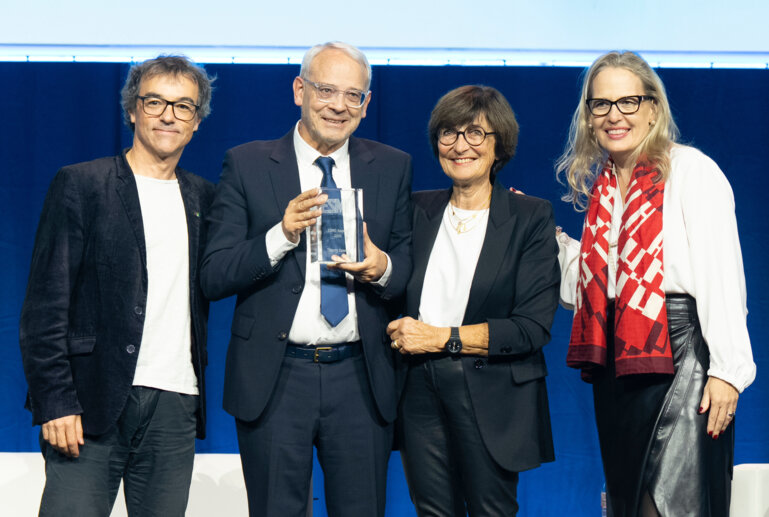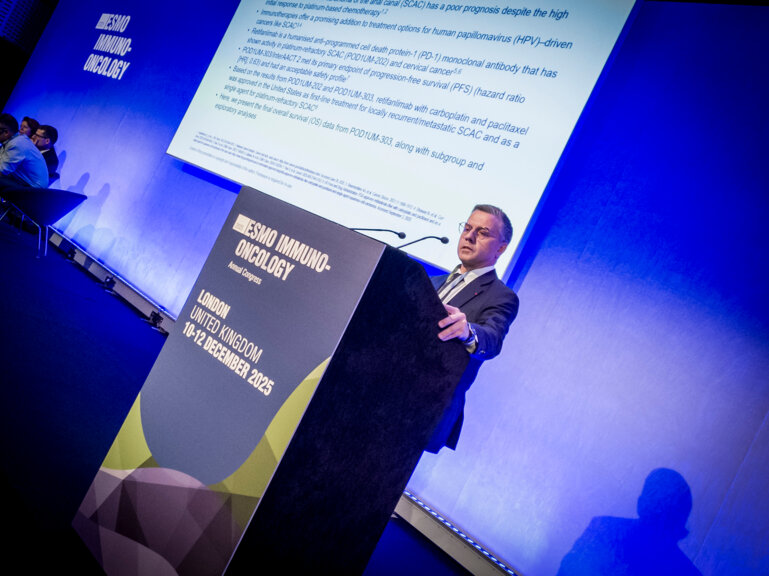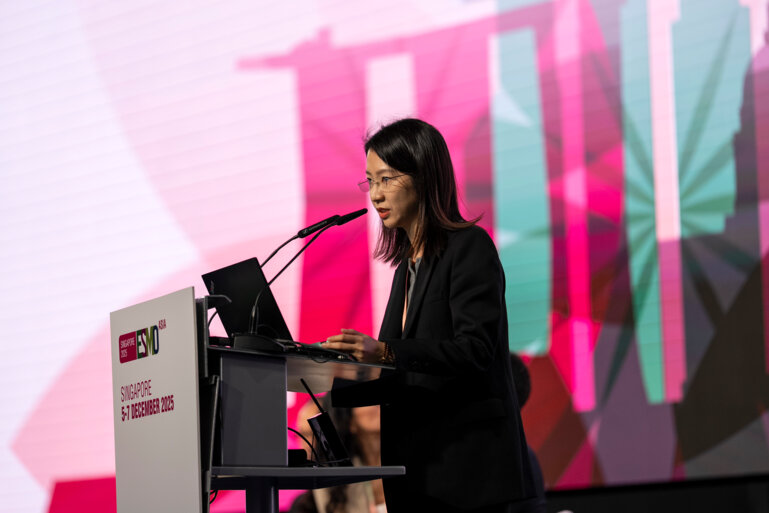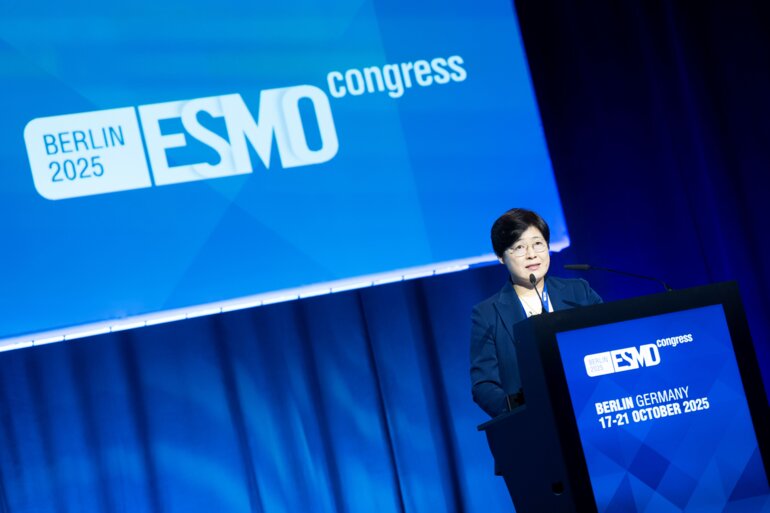The 2025 ESMO Awardee, Thierry Conroy, traces the major advances in the field while noting that several barriers to improving patient outcomes remain
In his career spanning more than 4 decades, Prof. Thierry Conroy, Professor of Oncology at the University of Lorraine, Nancy, France, has witnessed a profound transformation in the management of gastrointestinal (GI) cancers since the mid-1980s.
At the Opening Session of the ESMO Congress 2025 (Berlin, 17–21 October), Conroy received the ESMO Award in recognition of his remarkable contributions to the treatment of GI cancers, particularly in the development of the FOLFIRINOX combination chemotherapy regimen for the treatment of pancreatic and rectal cancers. As a member of the EORTC Quality of Life (QoL) group, he also played a significant role in the development and validation of most of the currently used QoL modules for fatigue and GI cancers.
What improvements have you seen since you began working in GI cancer management?
During the mid-1980s, chemotherapy options for patients with GI cancers were limited to agents such as 5-fluorouracil (5-FU), cisplatin, and mitomycin C. The challenge of improving outcomes through a better understanding of these cancers and through clinical research deeply interested me. At that time, cancer diagnoses were often withheld from patients, except in specialised departments or hospitals, and imaging-based staging was imprecise. Surgery alone was the standard of care, and chemotherapy was indicated only for patients with metastatic disease. At the Comprehensive Cancer Centre in Nancy, specialists were pioneers in nutritional support and pain management. Multidisciplinary tumour board discussions were standard practice by the 1980s, and all patients received structured post-treatment surveillance for 5 years.
By the early 1990s, physician–patient communication gained increasing importance. In parallel, imaging techniques evolved dramatically, resulting in improved precision and outcomes.
The first major breakthrough in GI medical oncology came in the 1990s with the introduction of adjuvant chemotherapy after resection of high-risk colon cancer. Neoadjuvant chemotherapy became standard for gastric and oesophageal cancers, while pre-operative chemoradiotherapy was established as the preferred approach for locally advanced rectal and oesophageal tumours, and as a non-surgical alternative for anal cancer. In the early 2000s, the first molecular tests became available, followed by comprehensive molecular profiling to guide targeted therapy. Genetic predispositions could be identified more rapidly, allowing for earlier interventions.
Systemic therapy has seen a series of landmark advances that have significantly improved patient survival, particularly in metastatic settings. These include combination chemotherapy regimens (based on infusional 5-FU, e.g., FOLFOX) and the introduction of targeted therapies: imatinib for gastrointestinal stromal tumours (GIST), anti-EGFR and anti-VEGF agents for colorectal cancer, and trastuzumab for gastric cancer.
What are your key contributions to the progress made in this field?
In my career, I have had the privilege of playing a role in a paradigm shift in the management of GI cancers. In oesophageal cancer, I contributed to the identification of vinorelbine (J Clin Oncol. 1996;14:164–170), vinorelbine and cisplatin (Ann Oncol. 2002;13:721–729) in EORTC trials, and FOLFOX (Lancet Oncol. 2014;15:305–314) in the PRODIGE5/ACCORD17 trial as active agents/regimens for patients with inoperable oesophageal cancer. Although chemoradiotherapy with FOLFOX did not increase progression-free survival (PFS), it was a more convenient and less toxic option than cisplatin plus 5-FU for patients with localised oesophageal cancer unsuitable for surgery.
In advanced pancreatic cancer, we demonstrated in the ACCORD 11 trial that FOLFIRINOX (folinic acid, 5-FU, irinotecan and oxaliplatin) significantly improved patient outcomes compared with gemcitabine – the standard of care since 1995. Median overall survival (OS; 11.1 months versus 6.8 months; hazard ratio [HR] 0.57; p<0.001), median PFS (6.4 months versus 3.3 months; HR 0.47; p<0.001), and objective response rate (ORR; 31.6% versus 9.4%; p<0.001) were significantly improved in patients with metastatic pancreatic cancer and good performance status (N Engl J Med. 2011;364:1817–1825). Patients treated with FOLFIRINOX also reported improved QoL across most EORTC QLQ-C30 domains. Toxicity was higher than with gemcitabine, but manageable. FOLFIRINOX, then modified (m) FOLFIRINOX (without bolus 5-FU) became a new international standard of care for patients with good performance status.
In patients with pancreatic cancer who had undergone surgical resection, we found that adjuvant mFOLFIRINOX improved median disease-free survival (DFS; 21.6 months versus 12.8 months; HR 0.58; p<0.001) and OS (54.4 months versus 35.0 months; HR 0.64; p=0.003) compared with gemcitabine in the UNICANCER-PRODIGE 24/CCTG PA6 trial (N Engl J Med. 2018;379:2395–2406). Clinical benefit was consistent across prognostic subgroups and was independent of age, margin status, and tumour characteristics.
In locally advanced rectal cancer, induction chemotherapy with FOLFIRINOX and chemoradiotherapy prior to surgery significantly improved metastasis-free survival and DFS, with some QoL benefits, compared with pre-operative chemoradiotherapy in the UNICANCER-PRODIGE 23 trial (Lancet Oncol. 2021;22:702–715; Ann Oncol. 2024;35:873–881). For the first time since 1997, we had shown that improvement in DFS translated into an OS benefit for patients with locally advanced rectal cancer.
What are some of the barriers to improving outcomes for patients with pancreatic cancer?
There are several barriers to improving outcomes for patients with pancreatic ductal adenocarcinoma (PDAC). Most notably is a late diagnosis; PDAC typically causes non-specific symptoms resulting in diagnostic delay (50–60% of patients present with metastatic disease), so the majority of patients are ineligible for surgery. Reliable tumour markers or early detection tools are urgently needed. PDAC also has an aggressive tumour biology, resulting in rapid disease progression. Therapeutic efficacy is limited by resistance to chemotherapy and radiotherapy, with few significant responses to immunotherapy, and a lack of actionable molecular targets in 90% of patients. However, progress in our understanding of PDAC is leading to some optimism in the identification of novel therapeutic opportunities.
What do you consider to be the key treatments currently in development for pancreatic and rectal cancers?
Numerous research programmes have been launched to study novel therapeutic strategies for pancreatic cancer, and some approaches appear particularly encouraging. For example, KRAS driver mutations – present in >90% of PDAC cases (most frequently as the G12D variant) – represent an attractive therapeutic target. Promising KRAS inhibitors and adjuvant vaccines targeting mutant KRAS are currently under development.
Individualised mRNA neoantigen cancer vaccines designed to expand neoantigen-specific T cells have already demonstrated encouraging immune responses when combined with immunotherapy and chemotherapy in patients with PDAC. A randomised clinical trial (IMCODE003) is currently underway with the mRNA vaccine autogene cevumeran in combination with atezolizumab and mFOLFIRINOX versus mFOLFIRINOX alone to evaluate the potential survival benefit in the adjuvant setting.
In terms of rectal cancer, immunotherapy offers significant hope for a small subset of patients with microsatellite instability-high/mismatch repair deficient tumours. As a next step, it will be interesting to evaluate the efficacy of combined chemo-immunotherapy in patients with microsatellite stable/mismatch repair proficient locally advanced rectal cancer.
Due to the numerous therapeutic options now available, treatment for rectal cancer is becoming increasingly personalised to the individual. However, long-term functional outcomes and QoL results are lacking for some trials, making treatment decisions complex for clinicians The development of decision-making tools could be instrumental in helping patients to better understand the consequences of treatment on their daily lives and make informed choices that align with their values and preferences.
Programme details
Conroy T. ESMO Award lecture: When science meets hope: Breakthroughs in academic pancreatic cancer trials. ESMO Congress 2025, Opening session








